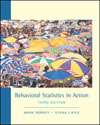Mark W. Vernoy,
Palomar College
Diana J. Kyle,
Fullerton College
| Addition rule of probability or addition theorem of probability | is used to compute the probability of one event or another event occurring. p (A or B) = p (A) + p (B)
|
 |
 |
 |
| Central limit theorem | states that as sample sizes increase, the distributions grow to more closely approximate the normal curve. When n is sufficiently large, then the distribution of sample means approaches a normal distribution. This is important for statistical inference, because when the sample is sufficiently large, it is assumed the distribution is normal.
|
 |
 |
 |
| Distribution of sample means | is a theoretical distribution made up of an unlimited number of sample means. In such a distribution, if all samples are the same size n, then the mean of the sample means will equal the population mean. <a onClick="window.open('/olcweb/cgi/pluginpop.cgi?it=gif:: ::/sites/dl/free/0767422759/35691/chap10g_1.gif','popWin', 'width=NaN,height=NaN,resizable,scrollbars');" href="#"><img valign="absmiddle" height="16" width="16" border="0" src="/olcweb/styles/shared/linkicons/image.gif"> (0.0K)</a> <a onClick="window.open('/olcweb/cgi/pluginpop.cgi?it=gif:: ::/sites/dl/free/0767422759/35691/chap10g_1.gif','popWin', 'width=NaN,height=NaN,resizable,scrollbars');" href="#"><img valign="absmiddle" height="16" width="16" border="0" src="/olcweb/styles/shared/linkicons/image.gif"> (0.0K)</a>
|
 |
 |
 |
| Multiplication rule of probability or multiplication theorem of probability | is used to compute the probability of two mutually exclusive events occurring together. p (A or B) = p(A) • p(B)
|
 |
 |
 |
| Mutually exclusive | indicates that two events cannot occur simultaneously.
|
 |
 |
 |
| Probability | is a measure of how likely it is that a given event or behavior will happen.
|
 |
 |
 |
| Random number table | is a table of numbers randomly generated by a computer. It can be used as a means of generating a random sample of a population.
|
 |
 |
 |
| Random sampling | is technique used to increase the chances of obtaining a representative sample. It assumes that by using a completely random selection process, everyone in the population is equally likely to be selected.
|
 |
 |
 |
| Representative sample | is a sample in which all significant subgroups of the population are represented.
|
 |
 |
 |
| Standard error of the mean | is the standard deviation of the distribution of sample means. As sample sizes increase, the standard error of the mean decreases. When the standard error of the mean is small, it indicates that the distribution of sample means has less error estimating the true population mean. <a onClick="window.open('/olcweb/cgi/pluginpop.cgi?it=gif:: ::/sites/dl/free/0767422759/35691/chap10g_2.gif','popWin', 'width=NaN,height=NaN,resizable,scrollbars');" href="#"><img valign="absmiddle" height="16" width="16" border="0" src="/olcweb/styles/shared/linkicons/image.gif"> (0.0K)</a> <a onClick="window.open('/olcweb/cgi/pluginpop.cgi?it=gif:: ::/sites/dl/free/0767422759/35691/chap10g_2.gif','popWin', 'width=NaN,height=NaN,resizable,scrollbars');" href="#"><img valign="absmiddle" height="16" width="16" border="0" src="/olcweb/styles/shared/linkicons/image.gif"> (0.0K)</a>
|
 |
 |
 |
| z test | is a statistical test used to compare the mean of a particular sample to the mean of a population. It can be used to determine how likely it is that a sample drawn is from the population. <a onClick="window.open('/olcweb/cgi/pluginpop.cgi?it=gif:: ::/sites/dl/free/0767422759/35691/chap10g_3.gif','popWin', 'width=NaN,height=NaN,resizable,scrollbars');" href="#"><img valign="absmiddle" height="16" width="16" border="0" src="/olcweb/styles/shared/linkicons/image.gif"> (0.0K)</a> <a onClick="window.open('/olcweb/cgi/pluginpop.cgi?it=gif:: ::/sites/dl/free/0767422759/35691/chap10g_3.gif','popWin', 'width=NaN,height=NaN,resizable,scrollbars');" href="#"><img valign="absmiddle" height="16" width="16" border="0" src="/olcweb/styles/shared/linkicons/image.gif"> (0.0K)</a>
|



 2002 McGraw-Hill Higher Education
2002 McGraw-Hill Higher Education

